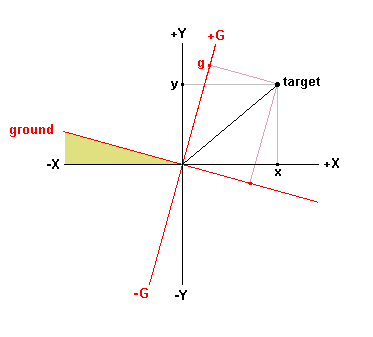
When I talk about a negative signal in metal detecting I may mean different things at different times. To explain two of the possible meanings of negative signal I will have to explain the graph above.
This graph has X and Y axes which I define by saying that the signal from a ferrite target lies on the -X axis and low conductivity non-ferrous targets lie on the +Y axis. I use a piece of ferrite as a reference target for calibration. A powdered iron transformer core would also work, or any non-conducting ferrous object. For a Y axis reference target I use the gold or silver colored write enable tabs for 5.25" floppies. These are metalized paper which have a very low conductivity. A superconductor would fall on the +X axis, but I don't happen to have any of those lying around so I don't have any +X reference targets. The x,y components of a target signal are the projections of the target onto the X and Y axes.
I have also drawn a ground balanced coordinate system in red. Most ground signals fall a little above the -X axis though wet salt can be way up near the +Y axis. You rotate the ground balanced axes when you turn the ground balance knob on your detector. You rotate the axes until the ground signal fall on the red axis I have labeled ground. You test for this by bobbing the coil up and down and listening to the ground balanced (G) signal. When the G axis is perpendicular to the ground signal the projection of the ground signal on the G axis is 0 and you cannot hear the ground. The g component of the target signal is the projection of the target on the G axis.
Now back to the issue of negative signals. When I am using the detector in the field and talk about getting a negative signal I am talking about a signal that falls in the shaded wedge between the ground axis and the -X axis. In that area g is negative (but y is positive). This happens when the coil passes over a rock or some dirt that has a phase angle that is more negative than the ground balance was set for. Detectors are usually set up so the all metal audio nulls on negative signals. Though if the self adjusting threshold (or autotune) is fast it may adjust itself while the coil is passing over the object and you will hear sound when the coil gets back to normal ground.
When I am talking about filtering and mention a negative signal I probably mean a -Y signal. Most of the time Y and G have the same sign. But in the wedges between the ground line and the X axis, G and Y do not have the same sign.
Also I might refer to a target with a negative phase angle as a negative target. Those targets have a -X component.
So in other words, when I say negative, you will never know what I mean.
Robert Hoolko
